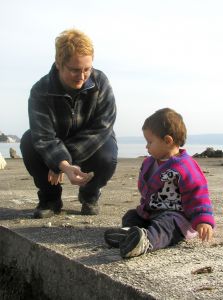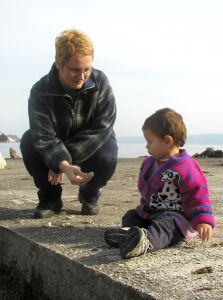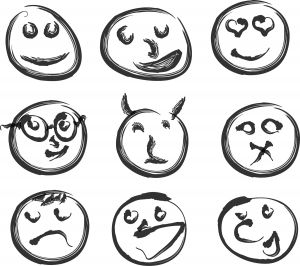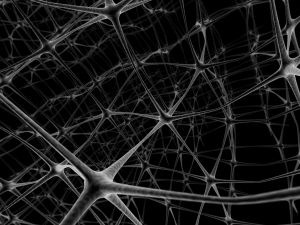By Rita Brhel, managing editor and attachment parenting resource leader (API)
 I don’t encourage the use of lovies – blankets, teddy bears, or other objects children can develop an attachment to – in my household but I don’t discourage it, either.
I don’t encourage the use of lovies – blankets, teddy bears, or other objects children can develop an attachment to – in my household but I don’t discourage it, either.
My three year old had earlier attachments to a teddy bear that had to be replaced once, and then we lost the bear somewhere, and for a long time, she didn’t have a lovie. But she also seemed to have more trouble sleeping, even sharing the family bed, so when she wanted to adopt a stuffed toy horse, I let her. Even snuggled up to me in my bed, she has to have her horsey. She also takes her horsey with her in the car most of the time, and when she can’t take it with her — let’s say, out to the garden — she asks me to hold it until she comes back.
Personally, I think her lovie is less for security and more because she’s watched me carry around her little sister the past year and a half. But, even if it is for security, I don’t feel threatened by it. I may not understand why she needs the security of a stuffed toy when we have a very secure relationship, but I would rather fill this need than not.
My 20 month old also has a lovie – her water bottle. Here is another situation that I feel neither threatened by nor any need to “wean” or “break” her of. Around the world, toddlers nurse themselves to sleep or in times of discomfort. My baby prefers to carry her bottle around – always with water – and when she does need to suck, she often wants to do so while sitting on my lap or lying down in bed beside me.
Discussion Continues on What the Use of Lovies Signals in a Parent-Child Relationship
On the API Forum, you can see other attached parents’ views of lovies in such threads as “Blankie or Teddie?” There are some parents who clearly see the attachment between a child and a lovie as a sign that the parent-child attachment is not strong, while other parents don’t see the same threat. Attachment Parenting International advises that parents honor this need in their children should they seem to want to sleep with or carry around a blankie, teddy, or other object. The exception would be if a child is likely to turn to food for comfort, which can set up an unhealthy association between food and comfort.
Weaning children off of pacifiers and bottles can be done similar to weaning a child off the breast – many attached parents let their children self-wean, while others may gently encourage that their children let go. One reader who commented on an API Speaks blog post, “Gently Weaning from the Pacifier,” explains how she poked a tiny hole in her daughter’s pacifier which made it less appealing to suck, and another parent explained to her daughter how the pacifier was broken.
Examine Your Perspective of the Lovie
So, what does your child’s lovie say about your attachment with her? This is still up for discussion and probably has something to do with how you view the lovie. If a parent encourages a lovie because he doesn’t want to focus on forming a strong attachment with his child, this isn’t appropriate. But if a parent honors his children’s need for a lovie while trying to continue strengthening the parent-child attachment — even in instances where he doesn’t understand this need — this would be following the API Principle of Responding with Sensitivity.
API’s Stance on Lovies
Q: What does API think of families using lovies?
A: Certainly we need to stress that a parent or other attached caregiver would be the best lovie a child could have. There is no substitute for the warm, loving arms of a caregiver and the security that they provide for the child. However, we realize that sometimes a lovie (such as a stuffed animal or blanket) can be an appropriate tool, and as long as it is not overused, it can be comforting to some children. Some high-needs children require almost constant contact with a parent or caregiver. Sometimes this level of contact is not possible, especially in a household with multiple children. For instance, if you need to lay the baby down to take a nap, but the baby wants you to lie with him or her and you are not able to, a lovie might be an acceptable fill-in. If the lovie carries the scent of the primary caregiver, it can be that much more soothing to the child. Additionally, for a child who is in a daycare, a lovie can be a comfort from home.
Introducing a lovie to a young infant could be as simple as tucking it into the sling with her while you carry her, or tucking it in with her as she sleeps contentedly in bed (with or without you). This should set up the lovie-sleep association. For an older toddler, introducing a lovie could be a bit more challenging since he will be more resistant to the caregiver substitute. Showing interest in it yourself may be enough to spark some curiosity for your child. Some children might enjoy being surprised with one, while others may prefer going to pick one out.
The most important thing to keep in mind is that the lovie should be associated with positivity to the child. Putting a child in a room to cry it out with a lovie sets up a negative association and is unfair to the child. Try to be understanding in the process of introducing a lovie, and realize that it may take time and gentle persistence for your child to accept one.
From the Frequently Asked Questions for the API Principle of Responding with Sensitivity on the API website
 A new report released by Phoenix Children’s Hospital in collaboration with a researcher at the University of Michigan concludes that there is little evidence that physical punishment improves children’s behavior in the long-term. Rather, the report cites substantial evidence that physical punishment puts children at risk for negative outcomes such as increased aggression and mental health problems.
A new report released by Phoenix Children’s Hospital in collaboration with a researcher at the University of Michigan concludes that there is little evidence that physical punishment improves children’s behavior in the long-term. Rather, the report cites substantial evidence that physical punishment puts children at risk for negative outcomes such as increased aggression and mental health problems. Research has, for many years, shown that the way a child is parented will physically shape his brain — that each interaction, good or bad, will create pathways within the brain as a reflection of the emotions surrounding that interaction. And that a pattern of neglect or abuse will shape the brain differently than will a consistently loving, attachment-promoting relationship.
Research has, for many years, shown that the way a child is parented will physically shape his brain — that each interaction, good or bad, will create pathways within the brain as a reflection of the emotions surrounding that interaction. And that a pattern of neglect or abuse will shape the brain differently than will a consistently loving, attachment-promoting relationship. Through Attachment Parenting, we learn how truly powerful a close emotional relationship with our children can be. But even with the strongest of bonds, conflict will arise between parents and their children. As children grow, AP focuses more and more on how we, as parents, resolve conflict — in a gentle, positive manner that promotes influence, guidance, and teaching rather than control.
Through Attachment Parenting, we learn how truly powerful a close emotional relationship with our children can be. But even with the strongest of bonds, conflict will arise between parents and their children. As children grow, AP focuses more and more on how we, as parents, resolve conflict — in a gentle, positive manner that promotes influence, guidance, and teaching rather than control. From API’s Publications Team
From API’s Publications Team Dear Readers,
Dear Readers,
 Custody cases are rarely pleasant, but in about 10 percent of these cases, it truly becomes a battle between the estranged parents and the long-term effects on their children’s mental wellbeing can be devastating.
Custody cases are rarely pleasant, but in about 10 percent of these cases, it truly becomes a battle between the estranged parents and the long-term effects on their children’s mental wellbeing can be devastating.